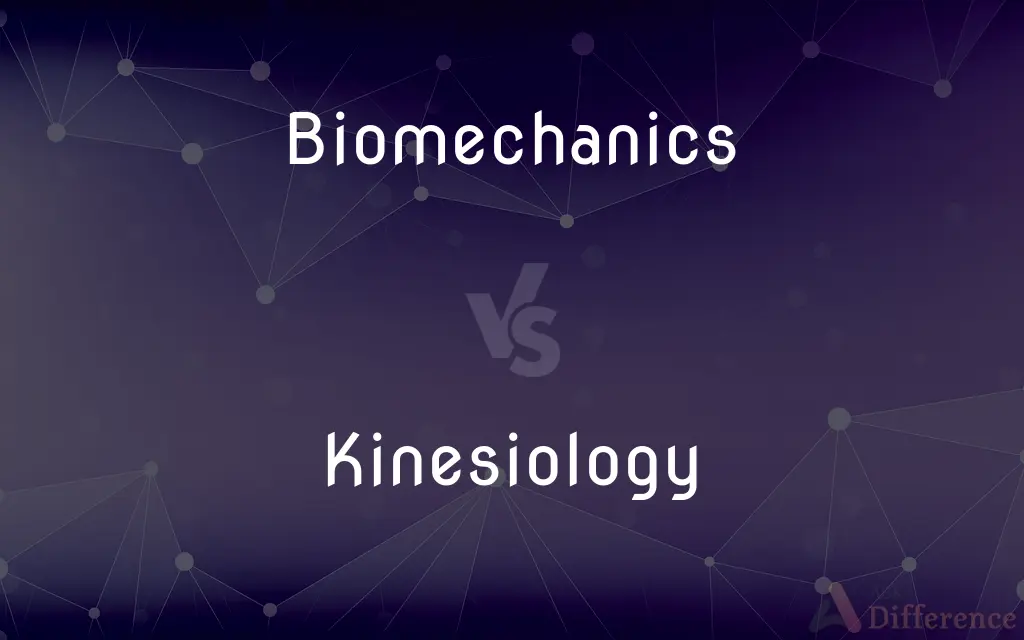Biomechanics vs. Kinesiology — What's the Difference?
Edited by Tayyaba Rehman — By Urooj Arif — Updated on March 31, 2024
Biomechanics focuses on the mechanics of movement in living organisms, while kinesiology studies human movement and its impact on health.

Difference Between Biomechanics and Kinesiology
Table of Contents
ADVERTISEMENT
Key Differences
Biomechanics applies principles of physics to understand biological systems' movements, emphasizing forces and their effects on structures. Whereas kinesiology encompasses a broader study of human movement, including physiological, psychological, and mechanical aspects, focusing on improving health and performance.
Biomechanics often uses mathematical and computational models to predict or analyze movement and forces on the body. On the other hand, kinesiology may utilize observational and experimental methods to study how movement affects overall health and function.
While biomechanics is crucial in designing prosthetics, sports equipment, and understanding injury mechanisms, kinesiology broadly addresses how movement and exercise influence health outcomes, including disease prevention and rehabilitation.
Biomechanics is integral to fields like orthopedics and sports science, providing insights into efficient movement patterns and injury prevention. Kinesiology, however, has a wider application in physical therapy, fitness training, and occupational health, emphasizing the role of physical activity in maintaining and improving health.
Biomechanics is a subset of kinesiology, focusing specifically on the mechanical aspects of movement, both fields overlap in their goals to enhance human movement and health. Kinesiology encompasses biomechanics as one of its many facets, along with other disciplines like anatomy and physiology.
ADVERTISEMENT
Comparison Chart
Focus
Mechanics of movement in biological systems
Study of human movement and its health implications
Methods
Mathematical and computational modeling
Observational and experimental methods
Application
Design of prosthetics, sports equipment, injury analysis
Physical therapy, fitness training, occupational health
Key Principles
Physics, engineering
Physiology, psychology, mechanics
Outcome Goals
Understanding and improving movement efficiency and injury prevention
Enhancing health, preventing disease, rehabilitation
Compare with Definitions
Biomechanics
Combining principles of physics, engineering, and biology.
Biomechanics applies Newton's laws of motion to understand how muscles generate force.
Kinesiology
Applying movement science to rehabilitate injuries.
Kinesiology principles guide the development of rehabilitation exercises for injured athletes.
Biomechanics
Analyzing athletes' movements to improve performance and reduce injury risk.
Biomechanics research can help refine a swimmer's stroke to minimize resistance in water.
Kinesiology
Investigating the role of physical activity in health promotion and disease prevention.
Research in kinesiology shows regular exercise can reduce the risk of chronic diseases.
Biomechanics
The study of the structure and function of biological systems using the methods of mechanics.
Biomechanics examines how the knee joint absorbs impact during running.
Kinesiology
The scientific study of human or non-human body movement.
Kinesiology explores how exercise affects muscle strength and endurance.
Biomechanics
Designing prosthetics and understanding injury mechanisms.
Biomechanics insights are crucial in developing more effective and comfortable prosthetic limbs.
Kinesiology
Teaching about body movement in health and physical education.
Kinesiology courses cover topics from anatomy and physiology to nutrition and wellness.
Biomechanics
Utilizing advanced technologies for movement analysis.
Motion capture systems in biomechanics provide detailed data on human movement.
Kinesiology
Designing workplaces to improve health and performance.
Kinesiology research can help design office spaces that minimize the risk of repetitive strain injuries.
Biomechanics
Biomechanics is the study of the structure, function and motion of the mechanical aspects of biological systems, at any level from whole organisms to organs, cells and cell organelles, using the methods of mechanics. Biomechanics is a branch of biophysics.
Kinesiology
Kinesiology is the scientific study of human or non-human body movement. Kinesiology addresses physiological, biomechanical, and psychological dynamic principles and mechanisms of movement.
Biomechanics
(used with a sing. verb) The study of the mechanics of a living body, especially of the forces exerted by muscles and gravity on the skeletal structure.
Kinesiology
The study of the mechanics of body movements.
Biomechanics
(used with a pl. verb) The mechanics of a part or function of a living body, such as of the heart or of locomotion.
Kinesiology
The study of the anatomy, physiology, and mechanics of body movement, especially in humans.
Biomechanics
The branch of biophysics that deals with the mechanics of the human or animal body; especially concerned with muscles and the skeleton.
Kinesiology
The application of the principles of kinesiology to the evaluation and treatment of muscular imbalance or derangement.
Biomechanics
(biology) The functioning of a particular part of a body.
Kinesiology
(medicine) The study of body movement.
Kinesiology
(medicine) The application of such principles to the diagnosis and treatment of muscular imbalance.
Kinesiology
The branch of physiology that studies the mechanics and anatomy in relation to human movement
Common Curiosities
What role does kinesiology play in healthcare?
Kinesiology applies knowledge of human movement to treat and prevent injuries and chronic diseases through exercise and physical activity.
How are biomechanics and kinesiology used in sports?
Both fields are used to enhance athletic performance, with biomechanics focusing on efficient movement mechanics and kinesiology on overall physical conditioning.
How does kinesiology contribute to rehabilitation?
It provides a scientific basis for designing exercise programs that restore movement and functional ability following injury.
What is biomechanics?
Biomechanics is the study of the mechanics of living organisms, focusing on the forces exerted by muscles and gravity on the skeletal structure.
Can biomechanics help in injury prevention?
Yes, by analyzing movement patterns and forces, biomechanics can identify potential injury risks and suggest modifications to prevent injuries.
How does kinesiology differ from biomechanics?
Kinesiology encompasses the study of all aspects of human movement, including physiological, psychological, and biomechanical, to improve health and performance.
Are biomechanics and kinesiology considered sciences?
Yes, both are multidisciplinary sciences that apply principles from physics, biology, and physiology.
What tools are used in biomechanical analysis?
Tools include motion capture technology, force platforms, and computational modeling software.
What is the importance of understanding biomechanics in sports?
Understanding biomechanics can improve performance and reduce injury risk by optimizing movement patterns and techniques.
How does one become a professional in biomechanics or kinesiology?
Professionals typically have a degree in kinesiology, biomechanics, or a related field, often with specialized graduate training.
What advancements have been made in biomechanics?
Advancements include improved prosthetic design, better understanding of injury mechanisms, and the development of wearable technology to monitor movement.
Can kinesiology help with chronic disease management?
Yes, through promoting physical activity and exercise, kinesiology can play a crucial role in managing and preventing chronic diseases.
Can kinesiology address mental health issues?
Yes, physical activity and exercise, key components of kinesiology, are proven to have positive effects on mental health.
What trends are shaping the future of kinesiology?
Trends include a growing emphasis on holistic health, the integration of technology in health assessment, and the use of exercise as medicine.
What is the relationship between biomechanics and physical therapy?
Biomechanics provides the foundation for understanding movement dysfunctions and designing therapeutic interventions in physical therapy.
Share Your Discovery

Previous Comparison
Babylon vs. Rome
Next Comparison
Marxism vs. PostmodernismAuthor Spotlight
Written by
Urooj ArifUrooj is a skilled content writer at Ask Difference, known for her exceptional ability to simplify complex topics into engaging and informative content. With a passion for research and a flair for clear, concise writing, she consistently delivers articles that resonate with our diverse audience.
Edited by
Tayyaba RehmanTayyaba Rehman is a distinguished writer, currently serving as a primary contributor to askdifference.com. As a researcher in semantics and etymology, Tayyaba's passion for the complexity of languages and their distinctions has found a perfect home on the platform. Tayyaba delves into the intricacies of language, distinguishing between commonly confused words and phrases, thereby providing clarity for readers worldwide.
















































